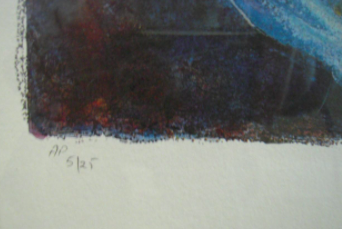What is an Artist’s Proof?
An artist’s proof is a term used in printmaking to describe a limited number of prints that are made outside of the regular numbered edition of a print. Artist’s proofs are typically printed before the numbered edition and are used as a way for the artist to make final adjustments to the image or to experiment with different colour combinations.
In traditional printmaking methods such as etching, engraving, or lithography, the artist will create an image on a matrix such as a metal plate or a stone. The matrix is then inked and printed onto paper or another substrate, resulting in a single impression of the image. In order to create an edition of prints, the matrix is used repeatedly to make multiple impressions of the image.
An artist’s proof is a print that is made using the same matrix as the regular edition but is set aside and marked as an artist’s proof rather than being numbered and included in the main edition. Typically, there are only a small number of artist’s proofs produced, often ranging from 10-20% of the size of the main edition.
Artist’s proofs are considered to be of higher quality than the regular numbered edition because they are made under the direct supervision of the artist and are often signed and annotated by the artist to indicate their significance. Artist’s proofs are also highly sought after by collectors and can command higher prices than the regular numbered edition.
In recent years, the term “artist’s proof” has been used more broadly to refer to any print that is not part of the numbered edition, including prints that are made after the edition has been completed or prints that are made outside of the traditional printmaking process. However, in the traditional sense, artist’s proofs are an important aspect of printmaking and provide an opportunity for artists to experiment and refine their work before committing to a larger edition.
Prints might also be annotated with the initials E.A. which stands for Épreuve d’Artiste, Artist’s Proof in French.

In addition to artist’s proof, there are other prints that may be made outside of the regular numbered editions:
Hors Commerce
H.C. stands for hors commerce, or ‘not to sell’. Similar to an artist’s proof, this proof was set aside from the editioned prints. Often the H.C. impressions were used as replacement or insurance copies for prints that were lost or damaged. Hors Commerce prints are identical to the editioned prints.
Printer’s Proof
Printer’s Proof prints are prints over and above the editioned prints that are given to the printer as thanks or in lieu of payment from the artist. Depending on the number of printers who worked on a piece as well as the arrangement between the artist and the printer, there may be multiple printer’s proofs of any given print. Printer’s Proof prints are annotated with P.P.
Bon à Tirer Prints
Bon à Tirer (B.A.T) or ‘ready to pull’ are prints annotated on the proof that was approved for final printing by the artist. The edition is then made in the image of the B.A.T. Only one of these such prints exists for each edition.
Trial Proof
A trial proof is any impression taken to test the development of the image, after which point the artist may decide to change things. There can be many trial proofs before the B.A.T. is created.

The value of an Artist’s Proof?
Artist’s Proofs are generally valued higher than other prints in the edition, due to the rarity and small quantity of them even though many artist’s proofs are typically identical to the editioned prints.
